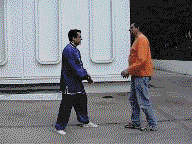|
Transition from Beginning Form to Grasp the Bird's Tail
While the postures of the T'ai Chi Chuan Form are important, the subtle dynamics of T'ai Chi Ch'uan lives in the transitions between the postures as exemplified in this usage of the transition from the "Beginning Form" to "Grasp the Bird's Tail" of Wu’s Slow Set (or, Long Form). T’ai Chi’s applications often do not involve grabbing or striking, but, instead, rely on the opponent's force to intercept, neutralize, and redirect, as is taught long term through T’ai Chi’s "Push Hands." Often these may be perceived as weaker techniques, yet most interpretations of the law today focus on the degree of force used regardless of the cause. This is where T’ai Chi Ch’uan makes it’s case as the "supreme ultimate fist" by using that which is necessary to diffuse a situation and not harm the other person as much as can be avoided.
|
| Application: |
Nei Jia (Internal) kung fu |
|
Wu Style Slow Set (or, Long form) Transition from Beginning Form to Grasp the Bird's Tail

About Nei Jia kung fu
The approach of Taijiquan, Xingyiquan and Baguazhang is to engage the opponent's aggression, maintain contact, and exploit weaknesses in the opponent's situation.
More About Nei Jia (Internal) kungfu |
|

